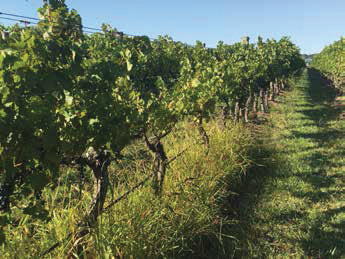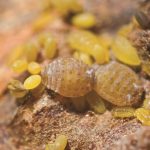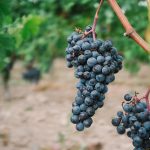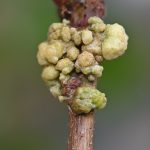This article was published in the March/April 2018 issue of the Wine & Viticulture Journal.
By Sonya Logan, Editor, Wine & Viticulture Journal
Phylloxera – it’s in Australia, has been described as the most economically destructive pest species of commercial grapevines in the world as evidenced by its decimation of vineyards in Europe in the late 19th and early 20th century, and the only effective control against it is to plant or replant vines on phylloxera resistant or tolerant rootstocks. So why is Australia’s uptake of these rootstocks so poor?
Just how poor? Well, we don’t exactly know. There simply isn’t an official national tally. However, by virtue of the state having a register of all vineyards planted within it, the South Australian uptake of rootstocks is known – 25% of all its vines are planted on them, reports Inca Pearce, chief executive of Vinehealth Australia. Yet phylloxera has never been detected in South Australia.
Over in Victoria’s Yarra Valley, the Yarra Valley Wine Growers’ Association (YVWGA) is confident it has a reasonable handle on the volume of vines on rootstocks in the region thanks to a data collection process its technical sub-committee carried out in 2016. This indicated that just 14% of the region’s vines were on rootstocks. Phylloxera was first detected in the Yarra Valley in 2006. Since then, the borders of the Phylloxera Infested Zone subsequently established to manage the spread of the pest have been expanded six times following further phylloxera detections in the region.
In a 2012 report summarising the current use of rootstocks in Australia, industry attitudes towards them and targets for future R&D into rootstock breeding and evaluation, author John Whiting noted estimates of 28% and 34% of vines planted to rootstocks in New South Wales and the Murray Darling, respectively. Whiting’s report also stated Victoria’s King and Alpine Valleys, both located in the North East Phylloxera Infested Zone, had been “largely replanted with grafted vines”. But, overall, “Australia has a low adoption of rootstocks compared with around 70% of vineyards worldwide planted on rootstock,” Whiting’s report said, adding, “the rate of rootstock planting is slow.”
So, why so slow?
The financial cost of replanting to rootstocks is an obvious one. Rootstock material alone can cost up to five times more than own-rooted material. The additional expense, explains Yalumba Nursery’s manager Nick Dry, is partly due to the fact more propagation material is needed to produce a single cutting: one rootstock cutting and a quarter of a scion cutting.
“There is more time and expertise involved in the process of preparing, grafting and waxing and the biggest factor is that the success rate of an own-rooted vine in the field nursery is, on average, 85% compared with 65% [for a rootstock cutting],” Dry adds. “This means that even if the cost of production for both (prior to planting in the field nursery) was $1.50, when you take into consideration losses (that is, 15% for own roots cv. 35% for grafted vines) the final cost equates to $1.75 compared with $2.50.”
And, then there’s the additional costs of replanting vines.
In 2017, Vinehealth Australia estimated the cost of replanting a vineyard with vines grafted onto rootstocks – including pulling out vines, purchasing the new grafted material, upgrading block infrastructure – was $60,000 per hectare. “That’s not withstanding the loss of production while plantings mature,” Inca Pearce adds.
With the recent slump in winegrape prices in Australia, a financial investment of this magnitude would have been lucky to cross the minds of many growers.
But the return to better profitability may not bring replanting to rootstocks closer to mind either.
Franco D’Anna, chair of the Yarra Valley Wine Growers’ Association, says many grapes are yielding good returns now in the region so growers are more inclined to hang onto the vines producing them.
“Some growers also still have the mentality that vines on own roots produce better wines,” D’Anna adds.
Furthermore, old own-rooted vines can be part of the marketing story for some vignerons.
“The fact is we don’t have 100% of winegrape plantings on phylloxera-resistant rootstocks, and we therefore have some of the oldest vines in the world here in Australia,’ says Inca Pearce. “Old vines are integral to many Australian brand stories.”
Then, of course, there are growers who have weighed up the odds of a phylloxera outbreak in their vineyards and “taken the view that the risks are small and they will manage the issue when it happens”, as the report from a 2014 Wine Australia-funded evaluation of investment into rootstock-related R&D put it.
Franco D’Anna is among those growers who are not prepared to take their chances and have been implementing replanting programs. Situated in the Upper Yarra, D’Anna’s Hoddles Creek Estate vineyard is outside the Yarra Valley PIZ, but lies in a Phylloxera Risk Zone (PRZ).
“We’ve replanted five blocks to rootstocks. We started with the blocks we didn’t really like first. Sauvignon Blanc was the first to go. Then we got rid of a block of Cabernet which isn’t really suited to the Upper Yarra,” D’Anna explains. To date, D’Anna has replanted 35% of his vineyard to rootstocks.
He says “a lot of the bigger guys, like Yerring Station, De Bortoli, and Oakridge Wines”, are driving the replanting programs in the Yarra, “but some of the smaller guys are putting plans in place to replant.” He says the first blocks usually singled out for replanting are varieties no longer popular in the region.
Of course, protection from phylloxera is not the only motivation for growers who choose to plant or replant using rootstocks. Nematode resistance, salinity and drought tolerance, management of fruit set and the rate of ripening, and vigour control are among various other reasons.
But for Brown Brothers, phylloxera is top of the list. Of its 834ha of company-owned vineyards planted throughout the Murray Darling, King Valley, Heathcote and Tasmania, 64% are on rootstocks. That includes 100% of its 250ha of vines in the Murray Darling, 100% of its 172ha in the King Valley and 100% of its 92ha in Heathcote. Of the total vines on rootstocks in Brown Brothers’ vineyards, 90% were greenfield plantings. While the Murray Darling is designated a Phylloxera Exclusion Zone, Heathcote lies outside the Nagambie Phylloxera Infested Zone and is in a declared PRZ.
Brown Brothers chief viticulturist Brett McClen says the vineyards his company purchased in Tasmania in 2010 were all on own roots. Like South Australia, Western Australia, and Northern Territory, the entire state of Tasmania is declared a Phylloxera Exclusion Zone. Since the 2010 acquisition, Brown Brothers has planted Pinot Noir vines for table wine production on a mix of own roots and rootstocks, meaning 6% of the company’s near 320ha of vines in the state are now planted to rootstocks.
If money were no object, would Brown Brothers have all its vines in the state on rootstocks too? “Not necessarily. We are still building our understanding of the impacts of rootstocks on wine quality in table Pinot Noir versus vines on own roots,” he admits.
Put the same question to Ben Harris, Treasury Wine Estate’s Australian and New Zealand viticulture manager, about its vast viticultural assets throughout Australia, and the response is similar.
“One of the key benefits of planting on rootstocks is the protection it affords against biosecurity risks,” Harris says. “However, TWE’s diverse wine portfolio and extensive vineyard holdings across Australia also require other elements, such as clonal and rootstock diversity, past performance of rootstocks within a particular region, fruit quality and different wine styles, to also be considered when we redevelop or plant new vineyards.”
He says while the figure shifts with vineyard acquisitions and sales and development programs, around a third of TWE’s vineyards are currently on rootstocks, adding an ongoing vineyard replanting program will see this proportion gradually increase. Around three-quarters of TWE’s Australian vineyards are located in South Australia and Victoria where the percentage of vineyards on rootstocks is growing as this replanting program continues, particularly in areas such as Coonawarra, Padthaway, Barossa, Eden Valley and McLaren Vale.
When it comes to rootstocks, not every rootstock suits every site. Franco D’Anna’s experience is just one example of this.
“101-14 is a great rootstock, but it doesn’t work on our site; it dries out too quickly,” he says.
Nick Dry says in the late 1990s, Vinehealth Australia, then known as the Phylloxera & Grape Industry Board of South Australia, identified three barriers to rootstock uptake – cost, uncertainty of performance and the potential for negative impact on wine quality.
“I think that the quality issue has now been put to bed. There is now much more experience with rootstocks across a range of sites and so there is less uncertainty on performance. Cost could be seen as a factor but I think there is now enough experience to show that the cost of planting material is pretty insignificant in the establishment and running costs of a vineyard,” Dry says.
“I think there is a preference for grafted vines over own roots in a replant situation. For new developments we probably see more own roots going in, but there is still a lot of grafted vines going into new sites.”
The last five years, Yalumba Nursery has sold around 60% of its vine material to South Australia, 25% to Victoria and 15% to other parts of Australia. Of this material 80% has been grafted onto rootstocks. Dry said the proportion of rootstocks to own-rooted vines sold had remained steady in recent years. He admits the biggest demand for rootstocks is out of the Yarra Valley, but sales in greater Victoria were also strong, with robust growth also recorded in Tasmania.
Dry says the reasons given by his customers for their rootstock purchases varies.
“In Victoria (outside PIZs), phylloxera is a major consideration and many consultants would say that you would be crazy to compromise your investment by planting on own roots. In SA and elsewhere there is probably more focus on water use efficiency, nematodes and consistency of yield – but I have no doubt that the insurance aspect [against phylloxera] is also a factor.”
Harris says TWE considers a number of elements when using rootstocks, such as “maximising fruit quality, providing protection against biosecurity risks, including phylloxera, and increasing the diversity within our vineyards to generate greater resilience against seasonal variability arising from dry, warm, cool or wet growing seasons.”
He says the majority of TWE’s new plantings are on rootstocks, excluding source blocks used for propagating material from its high quality heritage selections. The company also plants small sections on own roots at the same sites to provide comparisons with different rootstocks which “helps us improve our understanding of the performance and management of different rootstocks within individual regions”.
“Diversity is important in managing seasonal variability, so TWE uses clonal and rootstock diversity to reduce the impact of dry, warm, cool or wet vintages in term of fruit quality, as well as providing a range of different wine styles. Detailed soil analysis is completed before all new plantings, whether greenfield sites or replants. The variety, clone and rootstock is then selected based on what is most suitable for the site and macroclimate.”
TWE’s approach to rootstock use in replant situations is similar.
“Where we have an underperforming vineyard due to inferior heritage or health, or fruit quality that is below potential for the site, we carefully assess whether the vineyard should be replanted and, in the majority of these vineyards, they are replanted on rootstock. This same rationale is applied whether it’s a replant or a greenfield site, i.e., the rootstock is selected to maximise fruit quality and provide protection against biosecurity risks. The climate, vigour potential, soil type, soil depth, nematode population and the past performance of rootstocks within the region, are all taken into account when selecting planting material.”
Inca Pearce says research has shown that there is a 1:100 economic return for prevention activities for pests and diseases, compared with <1:1-5 for management activities once a pest or disease is established.
“Prevention is therefore key and planting on rootstock is a best practice activity.”
To protect those who haven’t adopted this best practice, adherence to the National Phylloxera Management Protocol, which covers the movement of grapevines, vineyard machinery, grapes, people and grape products from Phylloxera Infested Zones and Phylloxera Risk Zones into noninfested zones, is paramount, as are good farm hygiene practices.
“We see that best-practice farm-gate hygiene activities, including things like adherence to state plant quarantine standards, keeping visitor records, erecting signage and fencing, asking visitors where they have been prior to coming onto your property and training sessions for targeted end users such as tourism and cellar door staff, all go hand in hand as prevention and preparedness tools in a toolkit for growers and others in the wine industry.”
But surely the Australian wine industry could lift its game in adopting rootstocks to ensure it avoids disaster?
“We need to maintain a rational conversation about phylloxera by highlighting the risk and impact but also empowering growers and the industry with information and tools to prevent the spread and impact of phylloxera, and to manage and recover from an incursion,” says Pearce. “One of these protective measures is, of course, the use of rootstocks. Other preventative measures are rigorous farmgate hygiene and compliance with state quarantine regulations. As an industry, we need to remain vigilant in maintaining and strengthening these preventative measures, incorporating outcomes of research and development and ensuring active engagement with all industry stakeholders.”
As far as Franco D’Anna is concerned, growers in the Yarra Valley already have enough information to make educated decisions about the use of rootstocks.
“I don’t think anyone would be mad enough to plant on own roots in the Yarra now. If you have a chance to replant you’d be foolish not to put your vines on rootstocks. There’s plenty of information out there both within our association and outside. As an association we put on rootstock seminars to help growers make educated decisions about replanting to rootstocks. And Vinehealth Australia has given us quite a lot of support too,” explains D’Anna.
The YVWGA has even started up its own not-for-profit grafting business where local vineyard owners can provide scion material which is then grafted to their chosen rootstock and returned to their vineyard for callusing. D’Anna, who has used the service himself to generate planting material from his best block of Pinot, says this means growers only pay $3.65 per cutting instead of the going rate of $5.50. The pilot service was run for the first time in 2017 and grafted 16,000 vines. Expressions of interest for 2018 suggested this could leap to more than 101,000.
“More and more growers are starting to replant,” D’Anna says. “The trouble is, you’re never going to get everyone. The total cost involved in replanting is a big impediment. And the supply of rootstocks is quite limited. It takes 18-24 months before you can put rootstock planting material in the ground after ordering. You need a fair bit of forward thinking. And you need to make sure you choose the right rootstock for your site. It’s a massive decision.
“If you’re not in or near a Phylloxera Infested Zone, I think it’s easy to forget about the risks associated with phylloxera until you’re confronted with it. The Yarra Valley is exposed to phylloxera and we are using it as an opportunity to improve our sites and make better wines,” D’Anna says.
REFERENCES
Martin, G. (2014) Cost benefit analysis of winegrape rootstock research, development and extension. https:// www.wineaustralia.com/getmedia/5ad34d17-4c57- 4748-935a-60ccf80933a3/GWR-1308 Whiting, J. (2012)
Rootstock breeding and associated R&D in the viticulture and wine industry http://www.mvwi.com.au/items/517/Rootstock_ Review_-_John_Whiting_FINAL_(email).pdf .





















